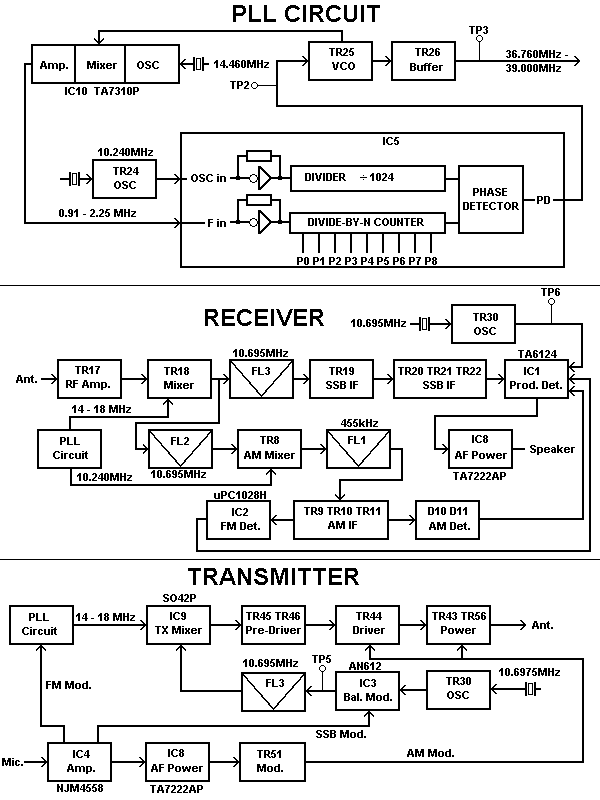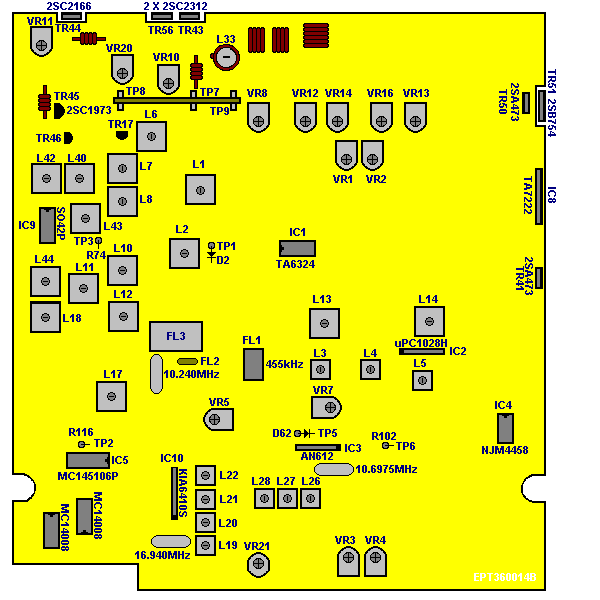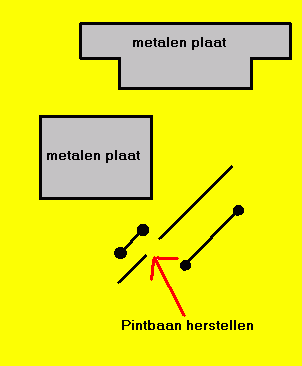Midland / Alan 87 |
|||||||||||||||||||||||||||||||||
|
|
||||||||||||||||||||||||||||||||
Midland / Alan 87 |
|||||||||||||||||||||||||||||||||
|
|
||||||||||||||||||||||||||||||||
PLL Circuitry.
PLL is an abbreviation of the phase-locked loop which is fundamentary composed of a closed loop feedback citcuit. The feedback component is the balance of frequency drift and the PLL circuit acts to cancel it out. To detect out the frcquency drift of the PLL output, a fixed reference ocillator (10 kHz, 1/1024 divided down from 10.240 MHz) is compared constantly with the input frequency (10 kHz). The input frequency is obtained by dividing the VCO frequency. A functionalI block diagram is provided below under "PLL Circuit" for the easier understanding.

Strumenti necessari per la taratura:
| Power Supply: 13,8 V | Frequency Counter | Dummy Load 50 ohm | Oscilloscope |
| DC Amperemeter | RF SSG | AF SSG |
Predisposizione iniziale dei
comandi:
| Clarifier | Mid. |
| SQ GAIN | Max. |
| AF GAIN | Max. |
| RF GAIN | Max. |
| MIC GAIN | Max. |
| MOD, S/RF | S/RF |
| NB/ANL | Off |
| Band | D |
| Channel | 19 |
| Reading Point | Condition | Adjustment | Procedure |
|---|---|---|---|
| PLL | |||
| IC5 Pin 3 | - | Check | 10.2400MHz |
| TP2 | Band:D, Ch.:40 | L17 | 5,0 Volt |
| TP3 | - | L18 | Maximum on Oscilloscope |
| OSCILLATOR | |||
| IC10 Pin 9 | AM | L19 | 16.9400MHz |
| IC10 Pin 9 | USB | L20 | 16.9425MHz |
| IC10 Pin 9 | LSB | L21 | 16.9375MHz |
| IC10 Pin 9 | TX AM | VR21 | 16.9400MHz (TX-Frequency) |
| TP5 | TX AM | L26 | 10.6950MHz |
| TP6 | RX USB | L27 | 10.6925MHz |
| TP6 | RX LSB | L28 | 10.6975MHz |
| TP5 | TX USB | VR7 | SSB Modulator Balance |
| RECEIVER | |||
| RX AM | L6 L7 L8 | RF Input | |
| RX AM | L10 L11 L12 | AM/FM/SSB IF | |
| RX AM | L3 L4 | AM/FM IF | |
| RX FM | L5 | Discriminator Coil (FM Demodulator) | |
| TP1 | RX USB | L1 L2 | Noise Blanker IF |
| RX USB | VR3 | SSB Squelch | |
| RX AM | VR4 | AM/FM Squelch | |
| AM/FM S- Meter | RX AM | VR1 | |
| SSB S- Meter | RX SSB | VR2 | |
| TRANSMITTER | |||
| TP9 (+) TP8 (-) | Bias Driver | VR11 | 10mA |
| TP9 (+) TP7 (-) | Bias Finale | VR10 | 100mA |
| TP9 (+) TP7 (-) | Bias Finale | VR20 | 100mA |
| TX AM | L42 | Maximum | |
| TX AM | L43 | Mixer Coil (VCO-frequency input) | |
| TX AM | L44 | Mixer Coil (TX-carrier 10.695MHz input) | |
| TX AM | L40 L42 | Maximum RF output | |
| TX AM | L33 | Minimum Harmonic | |
| TX AM | VR13 | 15 Watt (30 Watt with Dual Finale output) AM/FM | |
| TX USB | VR12 | 20 Watt (40 Watt with Dual Finale output) SSB (ALC) | |
| TX AM | VR14 | 90% AM-Modulation (AMC) | |
| TX FM | VR5 | 2 kHz FM-Deviation | |
| TX CW | VR16 | CW Tone (Not in all model`s) | |
| Power Meter | TX AM | VR8 | |
| Pin | Description |
|---|---|
| 1 | Ground |
| 2 | Microphone |
| 3 | TX Key (Connect to Ground) |
| 4 | Speaker (Connect to Ground) |
Lista
delle frequenze dei canali
MC145106P PLL Frequency Synthesizer
Modifiche Alan 87:
Activeren bandenschakelaar:
Schroef de bak open. Leg de bak met de knoppen naar u toe, met de soldeerzijde baar
boven.
Verwijder de oranje draad tegen het
voorfront.
Leg toestel op de soldeerzijde, met de knoppen naar u toe. U ziet dat op de
bandenschakelaar een paarse draad is
doorgeknipt, de losse paarse draad hangt in de draadboom. Herstel deze draad, ofwel
soldeer de draad opnieuw op de bandschakelaar.
| Modificatie voor 10 kc: Draai de
bak om met de soldeerzijde naar boven, met de knopen naar u toe. |
 |
Voor meer vermogen:
VR 13 voor AM. advies: maximaal 15 Watt
VR 12 voor SSB. advies: maximaal 25 Watt
| Ultimo aggiornamento: giovedě, 01 maggio 2008 12.25 +0200 |
| Copyright © www.i6bs.it 2000-2005. Tutti i diritti sono riservati. |